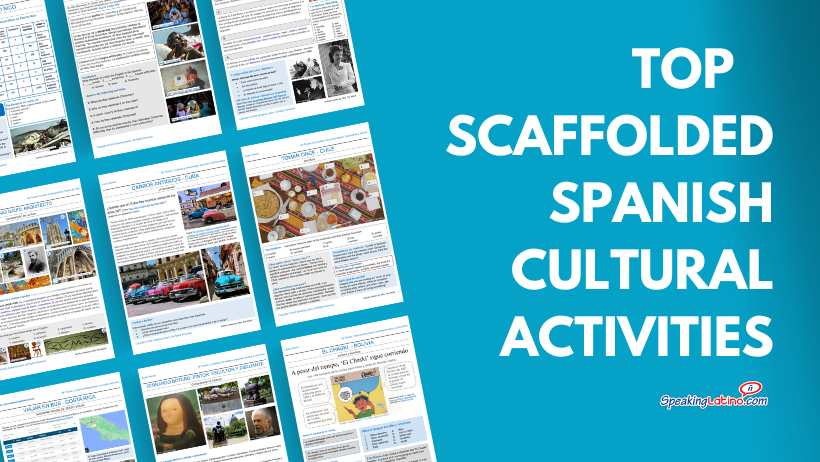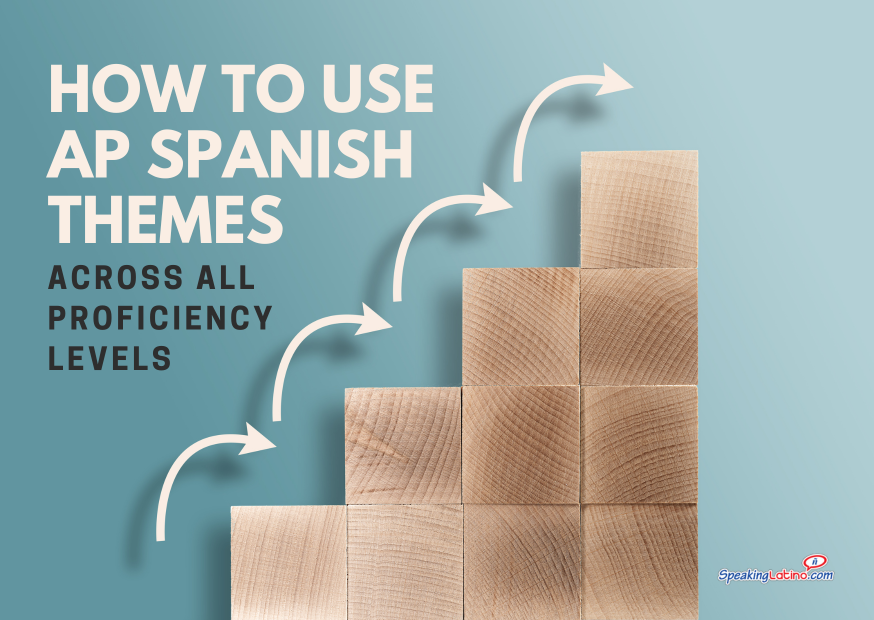
Spanish teachers prioritize creating engaging and effective learning experiences to nurture students' proficiency and cultural understanding. An innovative approach gaining momentum is the integration of scaffolded Spanish class activities aligned with Advanced Placement (AP) themes.
Explore the insights shared by Sheri Plath, an experienced Spanish teacher, and Jared Romey, the founder of the Spanish Teachers Community, as they discuss developing and implementing themed scaffolded activities designed to enhance Spanish language learning at various proficiency levels.
Why AP Spanish Themes from Novice Level
Sheri Plath stresses the significance of integrating AP themes and sub-themes into Spanish language instruction from the early stages of learning. Introducing these thematic elements exposes students to real-life experiences, cultural contexts, and societal issues relevant to Spanish-speaking communities. This approach not only enriches language learning but also provides students with a deeper understanding of the cultural nuances embedded in the Spanish language.
Demystify the Perception of AP Spanish Themes
With over 20 years of teaching experience across different proficiency levels, Sheri adopts a book-end approach, teaching both lower-level Spanish courses and advanced courses like AP Spanish. This method allows her to instill a passion for the language in students from the outset and guide them towards proficiency in higher-level coursework.
"Book-ending the curriculum" is a teaching approach where an educator teaches both lower-level and advanced courses in a subject, such as Spanish language instruction. This approach involves the teacher instructing students at the beginning levels of language proficiency (e.g., Spanish 1 or beginner levels) and also guiding them through higher-level coursework (e.g., AP Spanish or advanced levels).
Sheri advocates for introducing AP themes from the very first day of classes, even with students in Spanish 1. By incorporating Spanish AP themes into scaffolded activities early on, she aims to demystify the perception of AP coursework as unattainable, showing that students can engage with these themes from the very beginning of their language learning journey.
Using AP Spanish Themes Regardless of Proficiency Level
Sheri Plath emphasizes the alignment of scaffolded Spanish class activities with Advanced Placement (AP) themes and sub-themes to provide students with a comprehensive and contextualized learning experience early on.
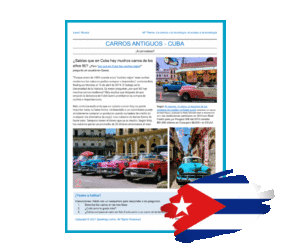
Here's how the scaffolded activities align with the AP themes and sub-themes:
1. Integration of Real-Life Experiences: The scaffolded activities are built around real-life experiences, places, and biographies from the Spanish-speaking world. By incorporating authentic cultural content into the activities, students engage with the AP themes in a meaningful and relevant way, connecting language learning to real-world contexts.
2. Thematic Focus: The activities are structured around the AP themes and sub-themes that are central to the AP Spanish Language and Culture exam. By organizing the activities around these thematic areas, students explore a wide range of topics related to identity, global challenges, science and technology, contemporary life, beauty and aesthetics, and personal and public identities, among others.
3. Contextualized Language Use: The scaffolded activities provide opportunities for students to use language in context while exploring the AP themes. This approach helps students develop their language skills in authentic situations, reinforcing vocabulary, grammar, and communication strategies within the thematic framework.
4. Cultural Awareness: Through the scaffolded activities, students gain insights into the cultural diversity of the Spanish-speaking world. By exploring themes related to cultural practices, traditions, and perspectives, students deepen their understanding of the rich cultural heritage associated with the language, aligning with the cultural components of the AP exam.
5. Progressive Complexity: The scaffolded approach allows for a gradual increase in the complexity of tasks and language use as students advance through the activities. By scaffolding the learning process, students are supported in mastering the language skills necessary to engage with the AP themes at a deeper level, preparing them for success in advanced coursework and the AP exam.
Global Perspectives in the Spanish Classroom
The scaffolded cultural activities bring a global perspective to the classroom. By incorporating cultural elements from various regions, students are exposed to a rich tapestry of Spanish language and culture, broadening their understanding of the global significance of language learning. This approach not only enhances linguistic skills but also fosters a sense of cultural appreciation and empathy among students.
Grounding the activities in real-life experiences, places, and biographies from the Spanish-speaking world, educators can provide students with a contextualized and meaningful learning experience.
Watch the full interview with Sheri Plath, the creator of the scaffolded cultural activities for the Speaking Latino Spanish Teachers Community.
Implementing Scaffolded Spanish Activities in the Classroom
Differentiated Tasks
Sheri and Jared emphasize the importance of preparing students for advanced language courses by grounding their learning in AP themes, even if they won't pursue doing the AP Spanish class in the future. The scaffolded activities are designed to gradually increase in complexity, catering to students at different proficiency levels.
By providing differentiated tasks, varied support materials, and adapted instructions, educators can effectively engage students and ensure that each learner receives the necessary challenges and support tailored to their proficiency level.
Here are ways in which these activities accommodate students at different proficiency levels:
- Beginners: For students at lower proficiency levels, activities may include basic vocabulary exercises, simple sentence construction tasks, and guided practice to build foundational language skills.
- Intermediate Learners: Intermediate students may engage in more complex tasks, such as role-playing scenarios, short dialogues, and reading comprehension activities with moderate linguistic challenges.
- Advanced Learners: Advanced students can tackle tasks that require critical thinking, analysis, and synthesis of information, such as debates, research projects, creative writing assignments, and presentations on advanced topics related to the AP themes.
Students may be grouped heterogeneously to allow for peer support and collaboration across proficiency levels. This can create a dynamic learning environment where students learn from each other and benefit from diverse perspectives.
Scaffolding Techniques
There are two main components for scaffolding techniques: supportive resources and gradual complexity.
Activities may provide supportive resources like vocabulary lists, grammar explanations, and cultural notes to assist students at all proficiency levels in understanding and completing tasks.
In addition, tasks in scaffolded activities are structured to increase complexity gradually, allowing students to progress from simpler tasks to more challenging ones as they develop their language skills and confidence.
Connecting Spanish Language Learning to Real-Life Experiences
One of the key aspects of the scaffolded activities is their focus on real-life experiences and biographies from Spanish-speaking countries. By integrating these authentic contexts into the activities, students can make meaningful connections between language learning and the world around them. This approach not only enhances linguistic skills but also cultivates a deeper appreciation for the cultural diversity and richness of the Spanish-speaking world.
Activities incorporate a range of cultural content that appeals to students at different proficiency levels, ensuring that learners of all backgrounds and language abilities can connect with the material and engage meaningfully with the themes and topics presented.
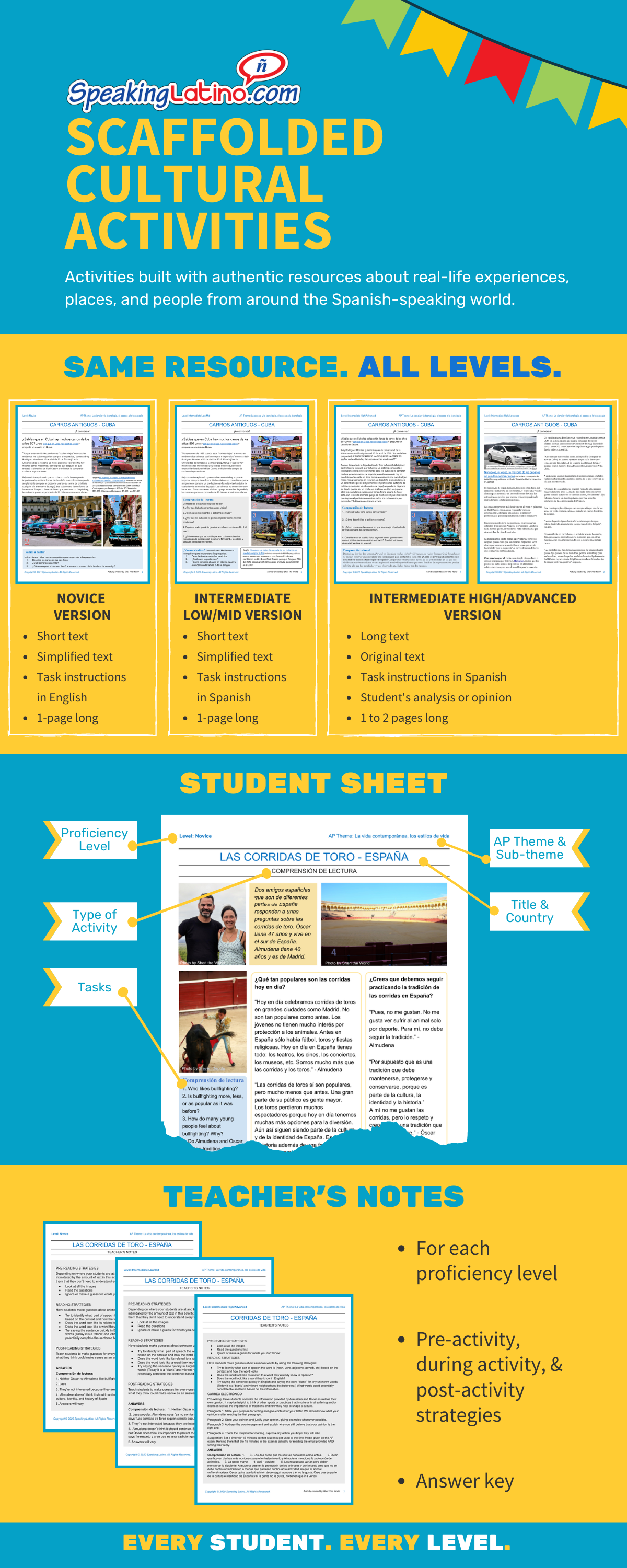
FAQ About Scaffolded Activities in the Spanish Classroom
What are some key benefits of using scaffolded activities in Spanish language classes?
Scaffolded activities offer several benefits in Spanish language classes:
1. Supports Differentiation
Scaffolded activities provide support at varying levels of complexity, allowing teachers to cater to the diverse needs of students with different proficiency levels.
2. Promotes Skill Development
By breaking down tasks into manageable steps, scaffolded activities help students develop their language skills gradually, leading to improved comprehension and communication abilities.
3. Enhances Engagement
These activities are designed to be interactive and engaging, fostering student interest and participation in the learning process.
4. Builds Confidence
The structured nature of scaffolded activities helps students feel more confident in their language learning journey as they progress through tasks with increasing levels of difficulty.
5. Facilitates Mastery
Through scaffolded activities, students can build upon their existing knowledge and skills, gradually mastering new language concepts and vocabulary in a supportive learning environment.
How can these themed activities be adapted for different proficiency levels?
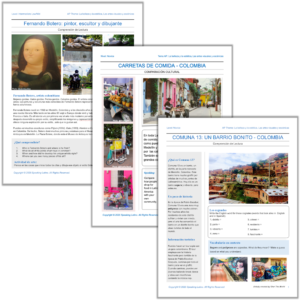
Adapting themed activities for different proficiency levels is crucial to ensure that all students are appropriately challenged and supported in their language learning journey.
Here are some strategies to adapt themed activities for various proficiency levels:
1. Differentiated Tasks
Create tasks that vary in complexity based on students' proficiency levels. For lower proficiency levels, provide more guided and structured tasks, while offering more open-ended and challenging tasks for higher proficiency levels.
2. Varied Support Materials
Tailor the support materials provided to students based on their proficiency levels. For beginners, include vocabulary lists, sentence starters, and visual aids to scaffold their understanding. Advanced learners may benefit from authentic texts, articles, and multimedia resources to deepen their engagement with the theme.
3. Adapted Instructions
Clearly communicate instructions in a way that is accessible to students at different proficiency levels. Simplify language and provide step-by-step guidance for beginners, while offering more complex and nuanced instructions for advanced learners.
4. Grouping Strategies
Consider grouping students based on their proficiency levels to facilitate targeted instruction and support. Pairing advanced students with beginners in collaborative activities can also create opportunities for peer learning and support.
5. Flexible Assessment
Design assessments that align with the proficiency levels of students. For beginners, focus on basic language skills such as vocabulary recognition and simple sentence construction. Advanced learners can be assessed on their ability to analyze and discuss complex themes in depth.
6. Scaffolded Learning Progression
Structure the themed activities in a way that allows for a gradual progression of difficulty. Start with foundational tasks that build essential language skills and gradually increase the complexity of tasks as students advance through the activities.
7. Personalized Feedback
Provide personalized feedback that addresses the specific needs and challenges of students at different proficiency levels. Encourage self-reflection and goal-setting to empower students to take ownership of their learning progress.
By implementing these adaptation strategies, educators can effectively cater to the diverse needs of students at various proficiency levels and ensure that themed activities are engaging, meaningful, and conducive to language development across the spectrum of proficiency.
What are some examples of real-life experiences, places, or biographies incorporated into these activities to make them more engaging for students?
Real-Life Experiences:
- Interviews: Students can conduct interviews with native Spanish speakers or individuals from Spanish-speaking countries to practice language skills and learn about different perspectives and experiences.
- Personal Narratives: Students can share their own personal experiences, such as travel stories, cultural encounters, or family traditions, using Spanish language skills to communicate effectively.
Places:
- Virtual Tours: Students can explore famous Spanish-speaking cities or landmarks through virtual tours, learning about the history, culture, and significance of these places while practicing language skills.
- Cultural Events: Activities can focus on specific cultural events or festivals celebrated in Spanish-speaking countries, allowing students to immerse themselves in the traditions and customs of different regions.
Biographies:
- Famous Figures: Students can research and present biographies of influential figures from the Spanish-speaking world, such as artists, writers, activists, or historical figures, to learn about their contributions and impact on society.
- Contemporary Profiles: Activities can involve studying the biographies of modern-day personalities from Spanish-speaking countries, such as athletes, musicians, entrepreneurs, or scientists, to explore current trends and achievements in the Spanish-speaking world.
Real-Life Experiences, Cultural Contexts, and Global Perspectives
The integration of scaffolded Spanish class activities aligned with AP themes represents a dynamic and innovative approach to language education. By incorporating real-life experiences, cultural contexts, and global perspectives into the activities, educators can create engaging and immersive learning experiences that enhance students' language proficiency and cultural understanding.
Through the utilization of thematic content, students can embark on a transformative language learning journey that prepares them for success in advanced coursework and fosters a lifelong appreciation for the Spanish language and its cultural heritage.
Done-For-You Scaffolded Cultural Activities Library
Sheri Plath has guided the Spanish Teachers Community in constructing a library of over 80 scaffolded cultural activities, ready for immediate use. These activities cover all themes and Spanish-speaking countries providing the flexibility to use them throughout the entire school year. Each activity offers three versions tailored for novice, intermediate, and advanced students.
